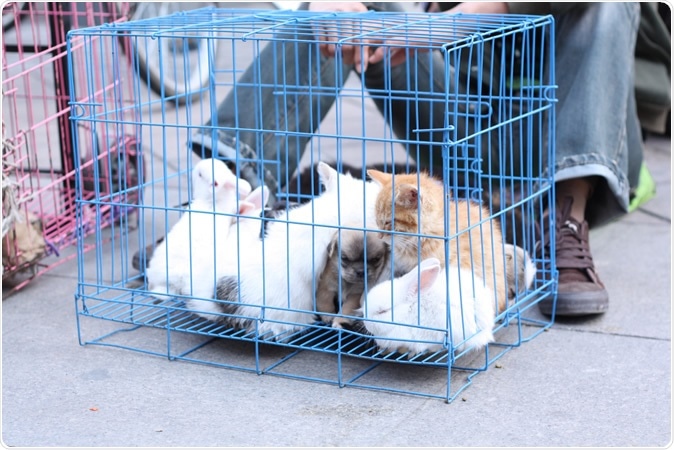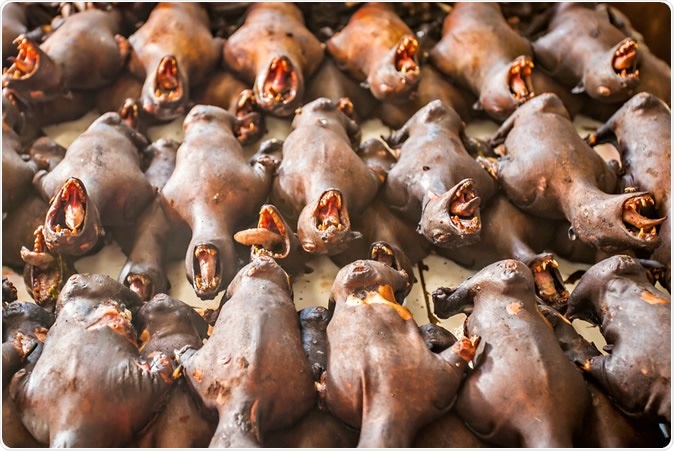As humans move to cities to settle, there is a sharp decline in biodiversity leading to several disturbances in the balance and relationship between humans and wild animals. A new study from researchers at the University of California, Davis' One Health Institute, shows that this has led to the spread of zoonotic viruses from animals to humans, such as COVID-19, which has caused a global pandemic involving over 184 countries and territories. The study was published in the latest issue of Proceedings of the Royal Society B.
This study was funded by the USAID Emerging Pandemic Threat PREDICT program and the National Institute of Health.

Small animals, rabbit, kitten, puppy, sharing a cage. Image Credit: Epov Dmitry / Shutterstock
What was the study about?
Human contact with wildlife has increased, say scientists. For this study, American and Australian researchers looked at all the pathogens that humans and animals share over time. They noted that there were 142 viruses that are shared between animals and humans over hundreds of years. These viruses have been connected between humans and several species of animals that are on the IUCN threatened list. The IUCN threatened list contains animals that are endangered.

Bird market in Kowloon, Hong Kong. Image Credit: Christian Mueller / Shutterstock
Domestic animals and animals living close to humans
The researchers explained that viruses are shared between humans and domestic animals such as sheep, pigs, goats, dogs, and cattle as well as domesticated birds. The number of viruses shared by humans and domestic animals was eight times higher than those with wild animals.
They write that several wild animals have become used to living in environments close to humans. With urbanization, animals such as rodents, primates such as monkeys, and other animals such as bats live closer to humans than before. These animals are responsible for causing around 75 percent of all the zoonotic viral infections in man. Bats are responsible for several zoonotic viral infections in humans, such as SARS (Severe Acute Respiratory Syndrome), Nipah, Marburg, and Ebola.

GUANGZHOU, CHINA - Chinese snake and reptiles market. Image Credit: tostphoto / Shutterstock
Why are viruses from wild animals spilling over to humans?
The new study reveals that threatened and endangered wild animal populations have declined. This has happened largely due to the loss of wildlife habitats, hunting, poaching and trading of parts of wild animals. This decline and contact with humans have also led to the spread of zoonotic infections, which were earlier restricted to wild habitats.
The study authors said, "Human encroachment into biodiverse areas increases the risk of spillover of novel infectious diseases by enabling new contacts between humans and wildlife … We found that species in the primate and bat orders were significantly more likely to harbor zoonotic viruses compared to all other orders."
Lead author Christine Kreuder Johnson, director of the EpiCenter for Disease Dynamics at the One Health Institute, a program of the UC Davis School of Veterinary Medicine, added, "Spillover of viruses from animals is a direct result of our actions involving wildlife and their habitat. The consequence is they're sharing their viruses with us. These actions simultaneously threaten species survival and increase the risk of spillover. In an unfortunate convergence of many factors, this brings about the kind of mess we're in now."

Roasted bats at Tomohon market, Sulawesi, Indonesia. Image Credit: Sony Herdiana / Shutterstock
What do we do now?
Johnson said, "We need to be really attentive to how we interact with wildlife and the activities that bring humans and wildlife together. We obviously don't want pandemics of this scale. We need to find ways to co-exist safely with wildlife, as they have no shortages of viruses to give us."
Open letter to WHO
Nearly 200 wildlife welfare organizations (including the International Fund for Animal Welfare, the Zoological Society of London, World Animal Protection, and Humane Society International and Peta) have written an open letter to the World Health Organization (WHO). They recommend that nations enforce stricter control on wildlife markets across the world and also ban the use of animals and their body parts in traditional medicine. The letter added that the COVID-19 pandemic has its origins in wildlife markets, and that is a warning that this needs to stop.
The letter says that this ban on wildlife markets can help stop the spread of zoonotic diseases and also prevent species extinction, which is primarily attributed to this form of trade. The letter reads, "This decisive action, well within the WHO's mandate, would be an impactful first step in adopting a highly precautionary approach to wildlife trade that poses a risk to human health." The letter added that over 2 billion cases of human diseases and over 2 million cases of deaths are a direct result of animal-to-human disease transmission. The diseases include Ebola, MERS (Middle East Respiratory Syndrome), HIV, rabies, bovine tuberculosis, and leptospirosis.
UN biodiversity chief Elizabeth Maruma Mrema has also called for a ban on wildlife markets given the global condition. Mrema is also the executive secretary of the UN Convention on Biological Diversity, and she explains that a large population, especially in Africa, is dependent on wildlife markets for food, and they need alternatives.
The letter to WHO added, "Matters regarding zoonotic diseases are outside of Cites's mandate, and the Secretariat does not have the competence to make comments on the recent news on the possible links between human consumption of wild animals and COVID-19."
Teresa Telecky, vice president of wildlife at Humane Society International, said in a statement, "The current COVID-19 pandemic has illustrated just how deadly the wildlife trade can be, not just for the wild animals involved, but also for people throughout the world. COVID-19 has killed thousands of people and will likely have lasting negative impacts on local and global economies." She added, "It is a tipping point that governments globally must not ignore. Wildlife markets worldwide are a petri dish for the next global pandemic, so governments across the globe must act to permanently ban the wildlife trade, including for food, medicine, fur, pets, and other reasons. Governments must also help those traders involved to find new livelihoods as quickly as possible."
Source:
Journal reference:
Christine K. Johnson, Peta L. Hitchens, Pranav S. Pandit, Julie Rushmore, Tierra Smiley Evans, Cristin C. W. Young and Megan M. Doyle 2020Global shifts in mammalian population trends reveal key predictors of virus spillover risk, Proc. R. Soc. B.28720192736 http://doi.org/10.1098/rspb.2019.2736